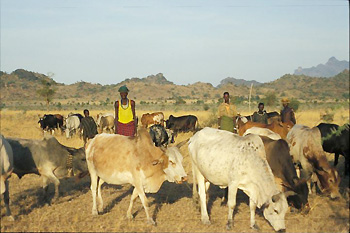| Period: 25 January 2005 - 23 March 2005. Country: Kenya, Uganda |
|
(1) Anthropological Study of Color Cognition and Animal Coat Color Among Pastoralists in East Africa |
| HAZAMA Itsuhiro (Division of African Area Studies) |
| Key Words: Visual Image, Metaphor, Identification, Color and Pattern, Pastoralist
|
 |
This poem was composed and sung for Meri-Akwangan ("an individual with white coat color spotted with black"; see the rightmost animal in the front line)
"Spotted with tiny, tiny dots, like the sky
An egg with spots!
Spotted with tiny, tiny dots, like the sky
It looks like stars
Like the sky seen from under a tamarind tree"
|
(2) This study aims to analyze the role of domestic animals' coat colors in relation to color cognition among pastoral societies in northeastern Uganda. Individuals in such societies keep domestic animals such as cattle, goats, sheep and donkeys, and all animals are individually identified. Coat color is an especially important characteristic that gives people clues for individual identification. People use the words for colors and combinations of these words as individual names of animals during herding and milking, and the individual animals are specified and indicated by these words during conversation. Color terms are also common in pastoral poetry that people compose and sing. Although it has been reported that domesticated animals are individually identified and remembered in pastoral societies, where one family herd consists of as many as several hundred domestic animals, there are significant uncertainties regarding the concrete physical differences in the animal's coat colors and the way in which people recognize them. This study attempts to analyze the following issues, by making special reference to coat color among other visual indexes of animals: (i) composition of coat color characterizing the appearance of animals, (ii) indigenous ways of color cognition, and (iii) visual images and their meaning with regard to the coat color of animals.
(3) This field research was carried out from January 5 to March 23, 2005 in the Moroto district in the northeastern part of the Republic of Uganda. Three results of the present field research are explained below in sequential order, in line with the three issues mentioned above.
- The results of open-ended interviews done based on photos of approximately one hundred cattle, goats and sheep provided an important supposition that there are few animals with uniform colors and that individuals differ in their color configuration. I will conduct two quantitative analyses to delve more deeply into this supposition, using photos of animals. Firstly, after segmenting each every animal's body surface into spots, the hue, brightness and saturation will be analyzed for each spot, and differences among individual animals will be compared in order to demonstrate their body color composition and determine the range of coat color diversity. Secondly, the distribution of dots of the same attribute will be analyzed to determine whether it is aggregated clumped dispersion, uniform dispersion or random dispersion, in order to determine how the diversity of animal coat color comes out, comparing flat and mixed color configurations among individual animals.
- The result of interviews involving showing people a color chart composed of one hundred cards of different flat colors provided data for analyzing the basic color terms of the Karimojong and their connotations. In addition, a “visual illusion” under which subjects described color patterns such as stripes and spots using cards of a flat color was also observed.
- The result of research on pastoral poetry made clear that all individuals with experience herding livestock have also composed their own poetry, that the frequency of the use of color terms is very high, and that the typical sequence of the poetry involves an unfolding from animals to other things in which the same colors stand out. It was also discovered that the Karimojong utilize visual images to express the motifs of their poetry by relocating colors, changing the way things are seen, enlarging or reducing the scale, reversing the background and figures, and creating “visual illusions” from the adjustment to darkness or brightness.
|

 21st Century COE Program
-Aiming for COE of Integrated Area Studies-
21st Century COE Program
-Aiming for COE of Integrated Area Studies-